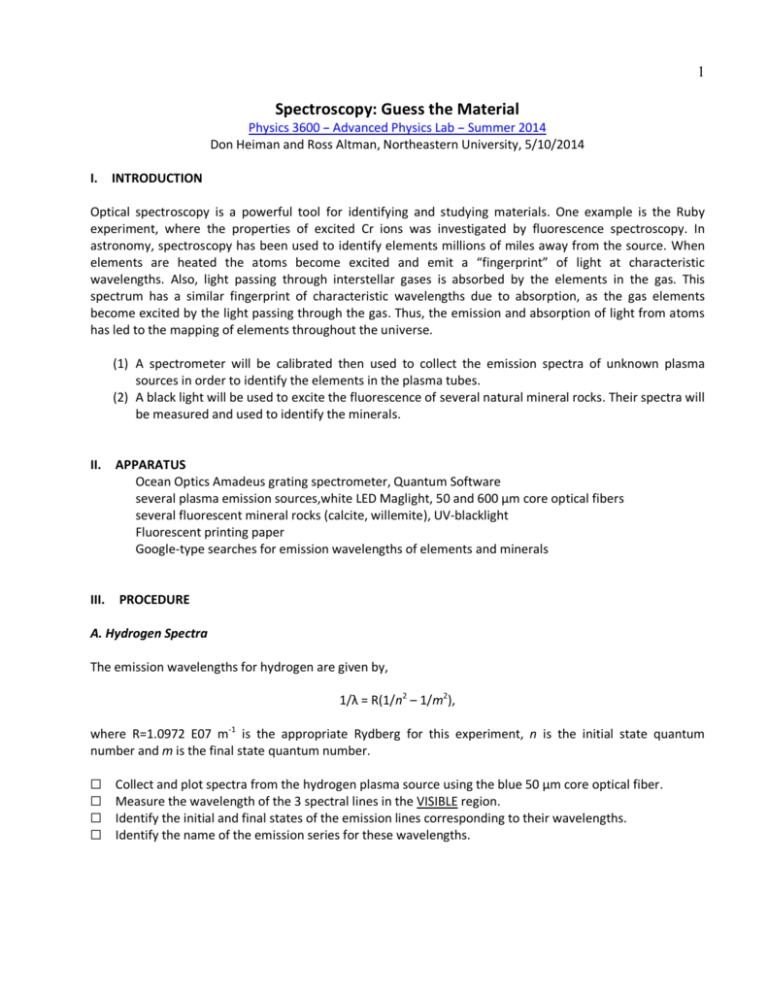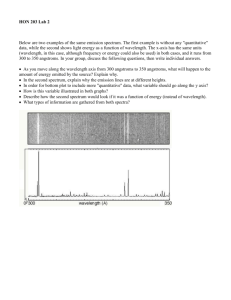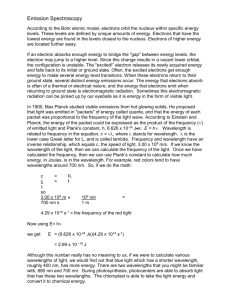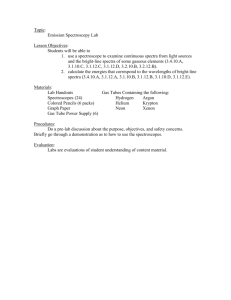Spectroscopy: Guess the Material
advertisement

1 Spectroscopy: Guess the Material Physics 3600 B Advanced Physics Lab B Summer 2014 Don Heiman and Ross Altman, Northeastern University, 5/10/2014 I. INTRODUCTION Optical spectroscopy is a powerful tool for identifying and studying materials. One example is the Ruby experiment, where the properties of excited Cr ions was investigated by fluorescence spectroscopy. In astronomy, spectroscopy has been used to identify elements millions of miles away from the source. When elements are heated the atoms become excited and emit a “fingerprint” of light at characteristic wavelengths. Also, light passing through interstellar gases is absorbed by the elements in the gas. This spectrum has a similar fingerprint of characteristic wavelengths due to absorption, as the gas elements become excited by the light passing through the gas. Thus, the emission and absorption of light from atoms has led to the mapping of elements throughout the universe. (1) A spectrometer will be calibrated then used to collect the emission spectra of unknown plasma sources in order to identify the elements in the plasma tubes. (2) A black light will be used to excite the fluorescence of several natural mineral rocks. Their spectra will be measured and used to identify the minerals. II. APPARATUS Ocean Optics Amadeus grating spectrometer, Quantum Software several plasma emission sources,white LED Maglight, 50 and 600 μm core optical fibers several fluorescent mineral rocks (calcite, willemite), UV-blacklight Fluorescent printing paper Google-type searches for emission wavelengths of elements and minerals III. PROCEDURE A. Hydrogen Spectra The emission wavelengths for hydrogen are given by, 1/λ = R(1/n2 – 1/m2), where R=1.0972 E07 m-1 is the appropriate Rydberg for this experiment, n is the initial state quantum number and m is the final state quantum number. G G G G Collect and plot spectra from the hydrogen plasma source using the blue 50 μm core optical fiber. Measure the wavelength of the 3 spectral lines in the VISIBLE region. Identify the initial and final states of the emission lines corresponding to their wavelengths. Identify the name of the emission series for these wavelengths. 2 B. Spectrometer Calibration G G For the red hydrogen emission line, measure the centroid wavelength (midpoint wavelength at half-maximum) and the full-width at half-maximum (FWHM) linewidth? If the red line is shifted by more than 1 nm from the accepted value, apply this calibration factor for all subsequent wavelength measurements. C. Emission Spectra of Plasmas G G G G G G Collect spectra from the unknown plasma sources (A,B,C,D,E) using the blue 50 μm core fiber. Shift the wavelength axes to account for the calibration error. On one graph, plot all the spectral curves shifted vertically to avoid overlap; label them A,B,C,D,E. Identify the elements in each plasma tube by the emission wavelengths. Use internet searches. Note that some sources may contain compound molecules that have several elements. Collect and plot a room light spectrum and identify the elements in the fluorescent room lamps. Make a table containing the (~3) strongest spectral lines of each plasma source in increasing wavelength. Include columns for: measured wavelength, accepted wavelength, difference wavelength, element, and relative intensity for a given source (100 for the strongest line of each source). D. Fluorescence Spectra of Minerals and Paper G G G G G G Set up to illuminate a mineral rock with the blacklight and 600 μm core optical fiber. Collect spectra from the blacklight, unknown minerals rocks and the paper. On one graph, plot all spectra, but shift the curves vertically to avoid overlap. For each spectra, choose a different linear (or log-y) scale so that the ROI peaks are easily visible. For each spectra, determine the central wavelength (midpoint wavelength at half-maximum) and the FWHM linewidth. Identify each mineral rock and their fluorescent activator element. Make a table containing the source (UV/rocks/paper), central wavelength, spectral FWHM linewidth, and color. List the mineral name and fluorescent activator element. E. White LED G G G IV. G G Collect a spectrum from the blue-colored white LED Maglight. Identify the spectral peak wavelengths and discuss their origins via web search. Discuss why the light appears white, as related to the physiology of the eye. SUMMARY Discuss your wavelength accuracy of the emission. Discuss how you would improve the experiment.



